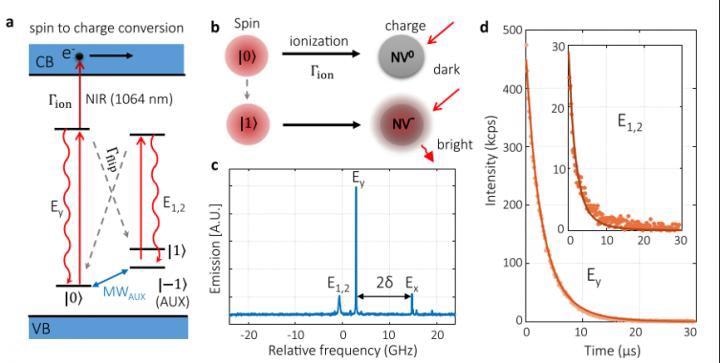Apr 2 2021
A team of scientists has devised a novel spin-to-charge conversion technique to realize high-fidelity readout of qubits, stepping closer toward fault-tolerant quantum computing.

(a) Energy levels used to achieve SCC. (b) A schematic diagram of SCC readout. (c) The excitation spectrum of the nitrogen-vacancy (NV) center used here at cryogenic temperature of 8 K. (d) Spin-flip process induces the photoluminescence (PL) decay. Image Credit: Qi Zhang et al.
The team was headed by Professor Jiangfeng Du and Professor Ya Wang from the Chinese Academy of Sciences (CAS) Key Laboratory of Microscale Magnetic Resonance of the University of Science and Technology of China.
In certain problems, researchers have fully demonstrated the supremacy of quantum computers over classical computers. However, the next breakthrough—fault-tolerant quantum computing—still necessitates the spin-readout fidelity and the accumulated logic gate error to surpass the fault-tolerant threshold.
Du and his colleagues previously resolved the first prerequisite in the nitrogen-vacancy (NV) center system, and the focus of this study was on the high-fidelity readout of qubits.
Qubit state, like spin state, is weak: a common approach for readout might lead to the flip between the 0 and 1 states for even a few photons, thereby causing a reading error. The readout fidelity of the conventional resonance fluorescence technique is strictly restricted by such property.
It is challenging to measure the spin state. Therefore, the researchers broke new ground to substitute it with a simple-to-readout and measurable property—the charge state.
First, the researchers compared the optical readout lifetime of the spin state charge and state. They found that the charge state is more stable compared to the spin state by five orders of magnitude. The results of the experiment indicated that the average non-demolition charge readout fidelity achieved was 99.96%.
Next, near-infrared (NIR) light (1064 nm) was used to trigger the ionization of the excited spin state, thereby converting the spin state 0 and 1 to the “electrically neutral” and “negatively charged” charge states, respectively. Through this process, the spin readout was converted into the charge readout.
The outcomes showed that the error of the conventional resonance fluorescence technique reached 20.1%, whereas the error of this new technique can be limited to 4.6%.
The study was published in the Nature Communications journal.
This new technique is compatible with the conventional technique, thus facilitating a spin-readout fidelity surpassing the fault-tolerant threshold in real applications. Moreover, this technique will effectively enhance the detection efficiency of quantum sensors since biological tissues and other samples are not much damaged by NIR light.
Journal Reference:
Zhang, Q., et al. (2021) High-fidelity single-shot readout of single electron spin in diamond with spin-to-charge conversion. Nature Communications. doi.org/10.1038/s41467-021-21781-5.